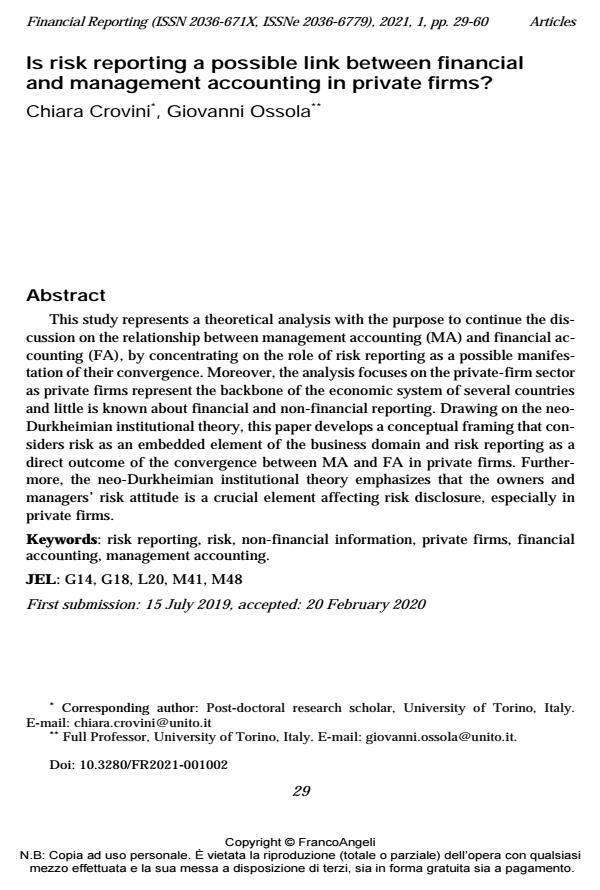Is risk reporting a possible link between financial and management accounting in private firms?
Journal title FINANCIAL REPORTING
Author/s Chiara Crovini, Giovanni Ossola
Publishing Year 2021 Issue 2021/1
Language English Pages 32 P. 29-60 File size 173 KB
DOI 10.3280/FR2021-001002
DOI is like a bar code for intellectual property: to have more infomation
click here
Below, you can see the article first page
If you want to buy this article in PDF format, you can do it, following the instructions to buy download credits

FrancoAngeli is member of Publishers International Linking Association, Inc (PILA), a not-for-profit association which run the CrossRef service enabling links to and from online scholarly content.
This study represents a theoretical analysis with the purpose to continue the discussion on the relationship between management accounting (MA) and financial accounting (FA), by concentrating on the role of risk reporting as a possible manifestation of their convergence. Moreover, the analysis focuses on the private-firm sector as private firms represent the backbone of the economic system of several countries and little is known about financial and non-financial reporting. Drawing on the neo- Durkheimian institutional theory, this paper develops a conceptual framing that considers risk as an embedded element of the business domain and risk reporting as a direct outcome of the convergence between MA and FA in private firms. Furthermore, the neo-Durkheimian institutional theory emphasizes that the owners and managers’ risk attitude is a crucial element affecting risk disclosure, especially in private firms.
Keywords: Risk reporting, risk, non-financial information, private firms, financial accounting, management accounting.
Jel codes: G14, G18, L20, M41, M48
- The journey toward the integrated reporting of Italian airport operators: Empirical evidence Antonio Thomas, Giuseppe Scandurra, in Business Strategy and the Environment /2023 pp.2896
DOI: 10.1002/bse.3277 - Managing cyber risk in the financial sector: Insights from a case study Chiara Crovini, Pier Luigi Marchini, in FINANCIAL REPORTING 1/2023 pp.97
DOI: 10.3280/FR2023-001004 - Market Valuation of Risk Reporting: The Role of Business Model Disclosure Chiara Crovini, Francesco Giunta, Christian Nielsen, Lorenzo Simoni, in Abacus abac.12342/2024
DOI: 10.1111/abac.12342
Chiara Crovini, Giovanni Ossola, Is risk reporting a possible link between financial and management accounting in private firms? in "FINANCIAL REPORTING" 1/2021, pp 29-60, DOI: 10.3280/FR2021-001002